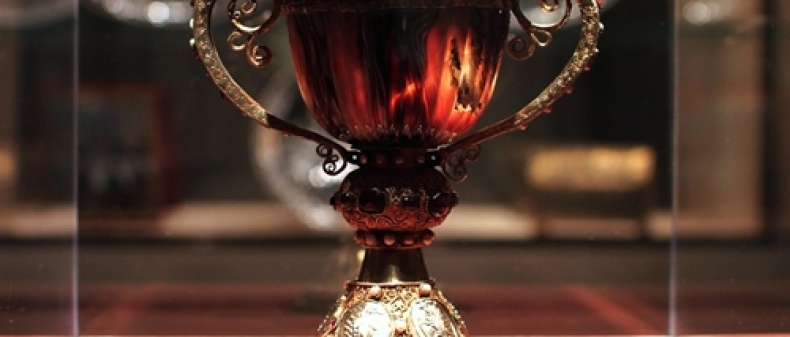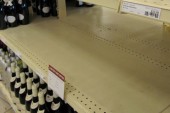
- The chalice of the Abbot of Suger (Photo: Flickr, Mr. T in DC)
Bringing your own bottle of wine is one thing, but would you bring your own wine glasses to a restaurant? Shortly before Christmas, pop star Madonna did just that. Just after midnight on December 20th, The New York Post (and dozens of other online gossip pages and blogs) reported that “Madonna and her boy toy Brahim Zaibat brought their own wine – and wine glasses – for a romantic dinner at the Upper West Side’s Osteria Cotta.” The “spies” further revealed that these were no ordinary stems, but rather “two beautiful crystal glasses.”
Admittedly what Madonna does on a Saturday night is not remotely interesting to me, but this story did catch my attention because it raises a larger issue for wine drinkers: how important is the drinking vessel for the overall enjoyment of wine?
After my previous pieces on proper serving temperature and the right food matches, I might be further accused of downplaying the importance of the wine itself (or worse, accused of snobbery) by saying that the vessel is an important part of the overall experience. But that’s exactly what I’m going to do. Glassware matters. But I have both history and modern neuroscience on my side, plus my own anecdotal evidence.
One need only point to the countless museums around the world and their impressive collections of wine vessels to illustrate their importance in society. They were, and still are, status symbols, an outward sign of respect towards guests. Heresy! You’ll say. Heavy lead crystal, hand blown Venetian glass, inlaid designs, intricate patterns, vibrant colours, precious jewels, silver and gold; none do anything to improve the aromas and flavours of wine. Indeed, they may detract from it. But I’ll argue that point. All these design elements have but one purpose: to impress the user.
Like a work of visual art that serves no purpose other than to set our orbitofrontal cortex firing, wine glasses are part of the entire neurological experience of drinking. The particulars of design are merely a question of fashion. In ancient Greece, the terracotta or ceramic kylix(chalice), with titillating scenes painted on the inside which were revealed only when emptied, was the wine cup of the upper class. In George Ravenscroft’s days (1632-83) it was the brilliant purity of lead crystal glasses. Today, it’s George Riedel’s creations: thin, sleek, generous crystal stems said to be fashioned in such a way as to enhance the characteristics of a wine made from a particular grape variety or region.
So does an ‘impressed’ drinker enjoy wine more? Modern neuroscience would argue that it does. Some time ago at a dinner I worked with Jonah Lehrer, a brilliant young neuroscientist with an impressive ability to interpret complex neurological brain patterns into practical everyday reality. I had selected wines, very good wines, and matched them to a multicourse menu. Before each course I described in some detail the particular qualities of the wines and why I believed them to be successful matches. And everyone seemed to agree.
Then Mr. Lehrer rose to give his speech. In less than 45 minutes, he proceeded to demolish the quality of my wine selections. Not maliciously, not because he didn’t enjoy the food and wine, but because his studies of the brain have shown that our aesthetic judgments are really complicated, and go way beyond any ability to smell and taste. “Your enjoyment of the wine,” he argued, “has little to do with the molecules you are sensing.” It turns out that innumerable variables “are capable of distorting our perceptions, so that we imagine differences that don’t actually exist.” In this case, with my preamble, I had set everyone up to like the wines and the pairings, so they were pre-disposed to enjoying them. I had inadvertently distorted their perceptions in a positive way. And, as any smart sommelier knows, this trick almost always works. It’s not only about the wine.
In a recent posting by Mr. Lehrer on Wired.com, he again examines the way in which our brains perceive beauty. He cites an experiment of subjects observing fake and real paintings by Rembrandt, hypothesizing that what we believe we are experiencing is a more powerful influence on our final impressions than what we are actually experiencing. “In fact, the same mental process also appears to drive our appreciation of expensive wine. In both instances, the sensory differences on display – say, the visual distinction between a real and fake Rembrandt, or the taste of Trader Joes Pinot versus a Romanee-Conti – are overwhelmed by our cognitive beliefs about what we’re experiencing.”
The importance of “cognitive belief” in wine enjoyment has already been proven by experiments using wine price as the sole variable. Subjects consistently rate a wine higher if they think it costs more, even when comparing two samples of an identical wine.
If you believe your host has pulled out his/her finest glassware to honor you, or that the glass chosen is the perfect type to emphasize the qualities of your Pinot Noir, cognitive science says you’ll like it more. Of course, the opposite must therefore also be true. A $100 bottle of wine served in a tumbler will likely titillate you measurably less.
So would I bring my own glasses to a restaurant I know has only the wretched Paris goblet, slayer of all fine wine? You better believe it. And I’ll save some money by making that $40 wine on the list taste like a $100 bottle. I guess Madonna really knows what she’s doing, or maybe it’s her boyfriend, who reportedly picked up the tab. Both left happily, arm-in-arm.
John Szabo is a master sommelier and wine writer for Toronto Standard. Follow his tweets here: @johnszabo.
Subscribe to our newsletter.














